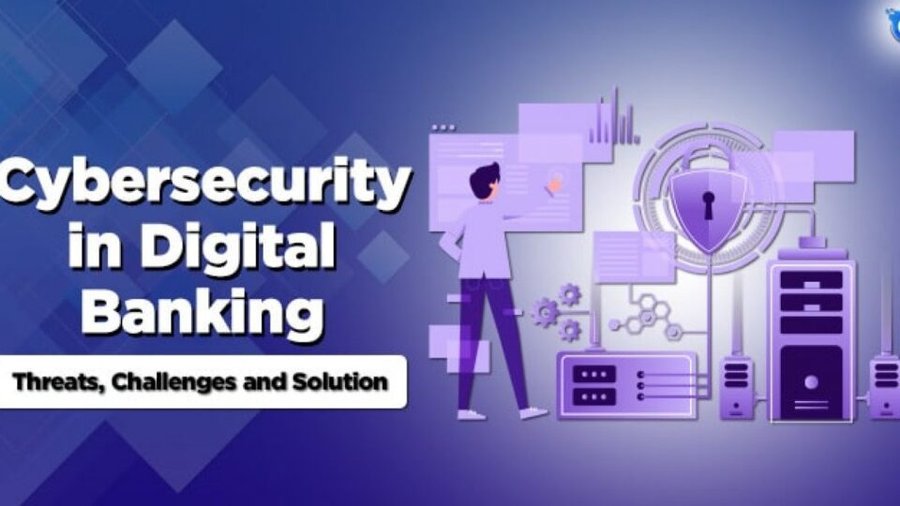In today’s digital age, where the banking sector relies heavily on technology, ensuring robust cybersecurity is of paramount importance. The financial industry has become a prime target for cybercriminals due to the vast amounts of sensitive data and financial assets it handles. This article explores the significance of cybersecurity in banking, the threats faced, and the challenges encountered in safeguarding financial institutions.
Table of Contents:
- Introduction to Cybersecurity in Banking
- The Importance of Cybersecurity in Banking
- Common Cybersecurity Threats in the Banking Sector
- 3.1. Phishing Attacks
- 3.2. Malware and Ransomware
- 3.3. Insider Threats
- 3.4. DDoS Attacks
- Challenges in Ensuring Cybersecurity in Banking
- 4.1. Rapid Technological Advancements
- 4.2. Regulatory Compliance
- 4.3. Limited Resources
- 4.4. User Awareness and Training
- Technological Solutions for Cybersecurity in Banking
- 5.1. Multi-factor Authentication
- 5.2. Artificial Intelligence and Machine Learning
- 5.3. Blockchain Technology
- The Role of Government and Regulatory Bodies
- Cybersecurity Best Practices for Banks
- 7.1. Regular Security Audits
- 7.2. Data Encryption
- 7.3. Incident Response Plans
- The Human Element in Cybersecurity
- Conclusion
- Frequently Asked Questions (FAQs)
Introduction
The banking industry is undergoing a digital revolution, with the majority of financial transactions and services being conducted online. While this has brought unprecedented convenience to customers, it has also opened up new avenues for cyber threats. In this article, we delve into the critical aspects of cybersecurity in banking.
The Importance of Cybersecurity in Banking
Cybersecurity is the shield that protects the sensitive information of banks and their customers from cybercriminals. It encompasses a set of technologies, processes, and practices designed to safeguard data, networks, and systems from unauthorized access, breaches, and theft.
Threat Landscape in the Banking Sector
The banking sector is under constant siege from a wide range of cyber threats. These threats are becoming increasingly sophisticated, and their impact can be devastating. Let’s delve into a few of the frequently encountered ones.
Common Cyber Threats in Banking
Malware Attacks
Malware, short for malicious software, is a significant concern for banks. Malware can infiltrate banking systems, steal sensitive data, and compromise the integrity of financial transactions.
Phishing Attacks
Phishing attacks involve tricking individuals into revealing confidential information, such as login credentials and credit card details. These attacks often target bank customers through deceptive emails and websites.
Insider Threats
Insider threats come from within the bank itself. Employees or contractors with access to sensitive data may misuse or leak information intentionally or unintentionally.
Challenges in Securing Financial Institutions
Despite recognizing the importance of cybersecurity, banks face several challenges when it comes to protecting their digital assets.
Rapid Technological Advancements
The fast-paced evolution of technology means that new vulnerabilities are constantly emerging. Banks must stay ahead of cybercriminals by adopting the latest security measures.
Compliance and Regulatory Requirements
Financial institutions must comply with strict regulations and industry standards regarding cybersecurity. Failing to comply can lead to substantial fines and harm the bank’s standing.
Human Error
Human error remains a significant vulnerability in cybersecurity. Training and awareness programs are essential to minimize the risk of employees inadvertently compromising security.
Third-Party Risks
Banks often rely on third-party vendors for various services. These vendors can introduce security risks if not properly vetted and managed.
Strategies for Enhancing Cybersecurity in Banking
To mitigate these challenges and enhance cybersecurity, banks can implement the following strategies:
Multi-Factor Authentication
Implementing multi-factor authentication adds an extra layer of security by requiring users to provide multiple forms of verification before granting access.
Continuous Monitoring
Real-time monitoring of network traffic and system activities can help detect and respond to threats promptly.
Employee Training and Awareness
Educating employees about cybersecurity best practices and potential threats is crucial in reducing the risk of human error.
Vendor Risk Management
Banks should assess and manage the security practices of their third-party vendors to ensure they meet cybersecurity standards.
Case Studies: Cybersecurity Success Stories
This section will highlight real-life examples of banks that successfully thwarted cyberattacks through robust cybersecurity measures.
Read more: Banking Cyber Security Market – Global Industry Analysis And Forecast
FAQs
Q1: What is the most common cybersecurity threat in banking?
The most common cybersecurity threat in banking is phishing attacks, which attempt to trick individuals into revealing sensitive information.
Q2: How can banks stay updated on the latest cybersecurity threats?
Banks can stay updated on the latest cybersecurity threats by actively monitoring industry news, participating in information-sharing networks, and engaging with cybersecurity experts.
Q3: What are the consequences of a data breach in a bank?
A data breach in a bank can lead to financial losses, damage to reputation, legal repercussions, and compromised customer trust.
Q4: Is cybersecurity a one-time investment for banks?
No, cybersecurity is an ongoing process that requires continuous investment and adaptation to evolving threats.
Q5: How can customers contribute to bank cybersecurity?
Customers can contribute to bank cybersecurity by practicing good online hygiene, using strong and unique passwords, and reporting any suspicious activity promptly.
In this era of digital banking, safeguarding financial institutions from cyber threats is an ever-evolving challenge. By understanding the importance of cybersecurity, recognizing the threats, and implementing effective strategies, banks can secure their digital future and protect the interests of their customers.
Emerging Trends in Banking Cybersecurity
As technology advances, the strategies employed by cybercriminals also adapt. Banking institutions must stay ahead of the curve to protect themselves and their customers. Here are some emerging trends in banking cybersecurity:
Artificial Intelligence and Machine Learning
Banks are increasingly using AI and machine learning algorithms to detect anomalies in network traffic and identify potential threats in real-time. These technologies can analyze vast amounts of data and adapt to evolving cyber threats.
Blockchain Technology
Blockchain has gained popularity in banking not only for secure digital transactions but also for enhancing cybersecurity. Its decentralized nature and cryptographic principles make it difficult for cybercriminals to tamper with transaction records.
Cloud Security
The adoption of cloud technology has provided banks with cost-effective solutions, but it also brings new security challenges. Ensuring the security of data stored in the cloud and during transmission is a top priority.
Read more: Cybersecurity and the Risk of Bank Failures
Zero Trust Architecture
Zero Trust is an approach that assumes no one, whether inside or outside the organization, should be trusted by default. This model requires continuous verification and validation of users and devices trying to access the network.
The Future of Cybersecurity in Banking
Looking ahead, the future of cybersecurity in banking holds both promise and challenges. Let’s explore some critical areas to keep an eye on:
Quantum Computing Threats
Quantum computers, when they become practical, could potentially break many of the encryption methods currently used in banking. Banks must prepare for this scenario by developing quantum-resistant encryption techniques.
Cybersecurity Collaboration
As cyber threats become increasingly complex, collaboration between banks, government agencies, and cybersecurity firms will be crucial. Information sharing can help identify and mitigate threats more effectively.
Cyber Insurance
With the growing recognition of cyber risks, banks are investing in cyber insurance policies to mitigate financial losses resulting from cyberattacks. These policies provide a safety net in the event of a security breach.
Ethical Hacking
Banks are embracing ethical hacking practices by hiring professionals to test their security measures. These ethical hackers, also known as “white hat hackers,” identify vulnerabilities before malicious actors can exploit them.
Conclusion
In conclusion, cybersecurity is not an option but a necessity for the banking sector. As technology progresses, cyber threats will also evolve. Banks must invest in comprehensive cybersecurity strategies to protect their assets, reputation, and most importantly, their customers.
Cybersecurity is the backbone of the modern banking industry. The importance of protecting sensitive financial data, maintaining customer trust, and adhering to regulatory requirements cannot be overstated. While cyber threats continue to evolve, so do the strategies and technologies to defend against them. Banks that prioritize cybersecurity as an ongoing investment will be better equipped to navigate the complex and ever-changing landscape of digital banking.
As the banking sector continues to evolve in the digital realm, cybersecurity remains a dynamic and essential component of its operations. Safeguarding financial institutions from cyber threats requires ongoing vigilance, adaptation to emerging technologies, and collaboration among industry stakeholders.
Image Source: Enterslice




